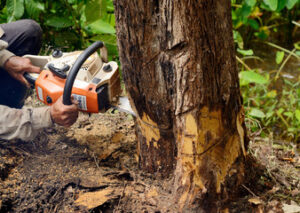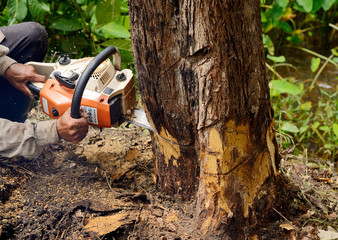Tree Removal is sometimes necessary to maintain safety and improve the appearance of a property. Overgrown or damaged trees can pose risks to nearby structures and people. Removing them requires careful planning and execution. Proper tree removal ensures minimal impact on the surrounding environment.
Understanding the reasons for tree removal is essential. Diseased trees can spread infections to nearby plants. Dead or dying trees lose structural integrity and become hazardous. Overcrowding can also prevent healthy growth among other trees and plants.
Evaluating tree health helps determine the best removal strategy. A professional assessment identifies signs of disease, rot, or infestation. Cracks, leaning, and hollow trunks are indicators of structural weakness. Early detection prevents potential damage and injury.
Tree removal involves more than cutting down a trunk. Roots, branches, and debris must be handled properly. Removing large trees requires specialized equipment and expertise. Professionals ensure the process is safe and efficient.
Safety measures are crucial during tree removal. Falling branches can cause injury or property damage. Proper protective gear and strategic cutting techniques reduce risks. Trained crews follow strict safety protocols to prevent accidents.
Environmental impact is a key consideration when removing trees. Removing a tree can disrupt the local ecosystem. Wildlife habitats may be affected by the loss of trees. Careful planning minimizes environmental disruption.
Tree removal can improve property aesthetics. Overgrown trees can block sunlight and limit landscaping options. Removing them creates more space for new plants or structures. A well-maintained landscape enhances curb appeal and value.
Storm damage often necessitates emergency tree removal. Strong winds and heavy rain can weaken tree roots and branches. Immediate removal prevents further damage to property. Quick response reduces the risk of secondary issues.
Tree stumps left after removal can cause problems. Stump grinding eliminates trip hazards and prevents new growth. Removing stumps also improves the appearance of the landscape. Professional stump removal ensures complete extraction.
Permits and regulations may apply to tree removal. Some areas have strict guidelines to protect certain tree species. Professional services handle permit applications and compliance. Following local regulations prevents legal issues and fines.
Removing diseased trees protects the health of surrounding plants. Fungal infections and insect infestations spread quickly. Removing infected trees prevents further damage. Early removal limits the spread of disease.
Tree removal can improve soil health and nutrient distribution. Overcrowded roots compete for nutrients and water. Removing excess trees allows remaining plants to thrive. Balanced root systems promote stronger and healthier growth.
Tree removal requires specialized equipment for large-scale jobs. Cranes, chainsaws, and protective gear ensure safe handling. Experienced crews operate machinery with precision. Proper equipment use prevents damage to nearby structures.
Strategic tree removal can enhance natural light and airflow. Dense canopies block sunlight and trap humidity. Opening up the landscape improves plant health and air circulation. Controlled removal creates a balanced environment.
Tree removal may be necessary for construction and development. New building projects often require clearing space. Removing trees makes way for foundations and infrastructure. Careful planning ensures minimal disruption to the surrounding area.
Root removal prevents underground damage to utilities. Tree roots can invade water lines and foundations. Removing problem trees protects underground infrastructure. Proper root extraction prevents future complications.
Selective tree removal preserves the integrity of the landscape. Removing weak or damaged trees strengthens the overall ecosystem. Careful selection ensures balanced growth among remaining trees. Healthy landscapes enhance long-term environmental stability.
Tree removal can prevent structural damage to buildings. Overhanging branches and leaning trunks pose risks to roofs and windows. Removing hazardous trees reduces repair costs. Early action prevents costly damage.
Seasonal factors influence tree removal timing. Removing trees during dormant seasons minimizes stress on surrounding plants. Cooler weather reduces the spread of disease and pests. Proper timing ensures smooth regrowth of nearby vegetation.
Tree removal allows for strategic replanting and landscaping. Open spaces create opportunities for new plant varieties. Selecting native species promotes ecological balance. Thoughtful planning enhances biodiversity and visual appeal.
Professional tree removal services offer insurance and liability protection. Trained crews handle potential risks and damages. Proper coverage ensures compensation for unexpected issues. Professional accountability increases peace of mind.
Tree removal improves overall property maintenance. Falling leaves and debris create cleanup challenges. Removing problem trees reduces maintenance demands. A cleaner landscape enhances property use and enjoyment.
Tree removal may be necessary after pest infestations. Insects and rodents often nest in weakened trees. Removing infested trees protects nearby vegetation. Early removal prevents pest migration.
Tree removal supports fire prevention efforts. Dry branches and dead trunks increase fire risks. Removing flammable material reduces the spread of wildfires. Proactive removal protects property and nearby areas.
Removing large trees requires advanced cutting techniques. Sectional cutting prevents sudden falls and structural damage. Controlled removal ensures even weight distribution. Skilled handling reduces risks during removal.
Tree removal can prevent soil erosion and water runoff. Overgrown root systems disrupt soil stability. Removing problem trees improves water absorption. Balanced root systems enhance soil health and moisture retention.
Tree removal enhances visibility and security. Overgrown branches block sightlines and create hiding spots. Removing obstructive trees improves property monitoring. Open spaces increase safety and awareness.
Tree removal supports healthy plant diversity. Overcrowded trees limit the growth of smaller plants. Removing large trees creates space for varied plant species. Increased diversity strengthens the local ecosystem.
Tree removal can increase property market value. A well-maintained landscape attracts potential buyers. Removing damaged or unsightly trees enhances curb appeal. Professional removal contributes to a polished appearance.
Tree removal addresses safety concerns for recreational areas. Public parks and playgrounds require secure surroundings. Removing unstable trees protects visitors from injury. Well-maintained green spaces improve community use.
Tree removal promotes long-term landscape health. Removing diseased or dying trees prevents future problems. Balanced growth among remaining trees enhances visual harmony. Thoughtful removal supports sustainable landscaping.
Tree removal can reduce noise pollution. Dense tree clusters trap and amplify sound. Opening up the landscape allows sound to dissipate. Strategic removal creates a quieter and more peaceful environment.
Tree removal reduces competition for sunlight and nutrients. Overcrowded trees block light and limit plant development. Removing excess trees enhances resource availability. Balanced growth improves plant health.
Tree removal prevents damage to underground infrastructure. Roots often disrupt sewer lines and foundations. Removing invasive trees protects underground systems. Careful root extraction prevents long-term issues.
Tree removal increases the functionality of outdoor spaces. Overgrown trees limit usable yard areas. Removing them creates room for new landscaping or structures. Improved functionality enhances property value and use.
Tree removal requires careful disposal of debris. Professional services handle recycling and waste removal. Sustainable disposal practices minimize environmental impact. Proper cleanup ensures a tidy and finished result.
Tree removal can improve the health of nearby vegetation. Diseased or dying trees affect soil quality and plant health. Removing problem trees restores soil balance. Improved soil conditions support healthy plant growth.
Tree removal supports controlled landscape design. Removing specific trees creates balance and symmetry. Open spaces allow for creative planting options. Well-planned design increases visual appeal.
Tree removal improves property drainage and water management. Overgrown roots block water flow and retention. Removing problem trees enhances drainage efficiency. Improved water flow prevents flooding and soil erosion.
Tree removal creates opportunities for hardscaping and outdoor features. Open spaces allow for patios, walkways, and garden beds. Removing obstructive trees expands design possibilities. Thoughtful removal enhances outdoor living.
Tree removal can uncover hidden structural issues. Roots and branches often mask foundation damage. Removing problem trees reveals underlying problems. Early detection allows for timely repairs.
Tree removal supports seasonal plant rotation. Open spaces create room for varied planting schedules. Seasonal changes enhance landscape variety and health. Thoughtful removal increases gardening flexibility.
Professional tree removal ensures long-term landscape stability. Proper handling of roots and branches prevents future issues. Professional expertise guarantees balanced growth. Well-managed landscapes enhance property value and appeal.
